
BMW i4 2024 Review, Range & Pricing

Introduction
We know what you are thinking:
“Oh great, here comes BMW with another odd-looking electric mini-SUV that I’ll look utterly stupid behind the wheel of.”
That is what we thought when we first heard of the i4, which was unveiled as a concept car in Munich last year.
Then BMW took the covers off.
Select's rating score* - 4.3 / 5
At a Glance
You see, this time, it isn't an odd-looking electric mini-car like the i3. Instead, this is a proper, normal-looking car going head-to-head with BMW’s own 3 and 4-series.
But the i4 isn’t a car to convince you to ditch your rugged 3-series for an electric-powered alien-like monstrosity. Truly, the i4 marks the proper start of the shift from our fossil-fuelled saloons into a perfectly normal-looking car that happens to be all-electric.
It is about time, too, as the consistently popular 3-series is now being outsold by Tesla’s Model 3 for the first time. And the Germans were never likely to take that particularly well.
Admittedly, there will be some who will say the i4 is a monstrosity. But that is more to do with BMW’s new design philosophy. This includes the new-style elongated kidney grilles at the front.
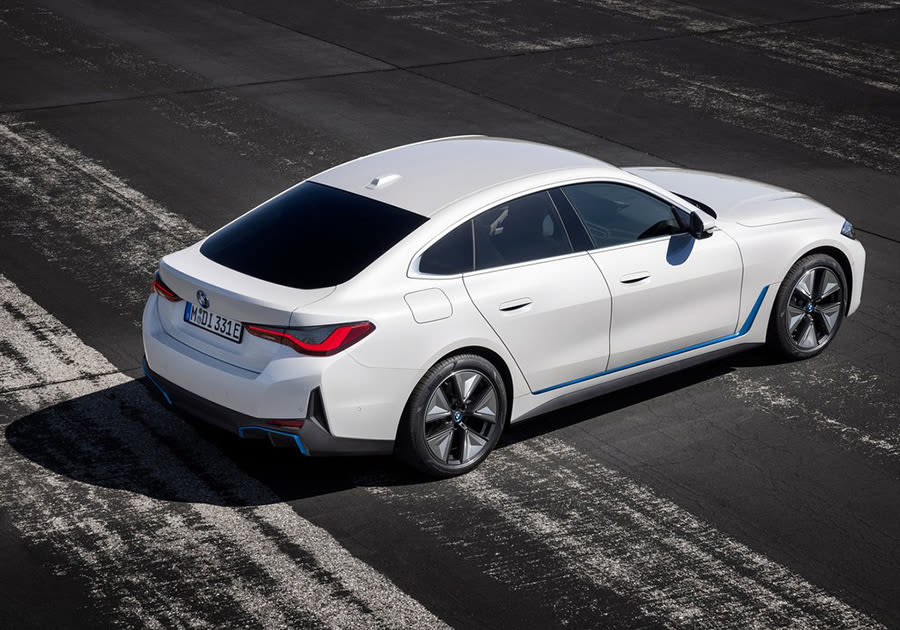
Most will say the i4 looks the part. Ironically, the utterly humungous kidney grilles are what grab your attention even though grilles aren’t needed on an electric car. But, of course, a BMW without kidney grilles is like a cheese sandwich without cheese. So, it is completely understandable that BMW has chosen to keep them, even if they’re more like unperforated decorative shields now.
If you can take your eyes off them, then you will see the ultra-aggressive stance of the car. The incredibly thin headlights angle down angrily while two large air intakes sit at either side like chiselled cheekbones.
Down the side, you will find a neat crease halfway down the doors, giving the BMW leaner proportions. At the same time, a coloured streak runs down behind the wheel arch and along the top of the side skirts.
For the avoidance of doubt, the i4 is, strictly speaking, an electrified version of its 4-series Gran Coupe. But then the 4-series itself is based on the 3-series. Nevertheless, we expect it will appeal to anyone who owns a premium-brand saloon of any sort.
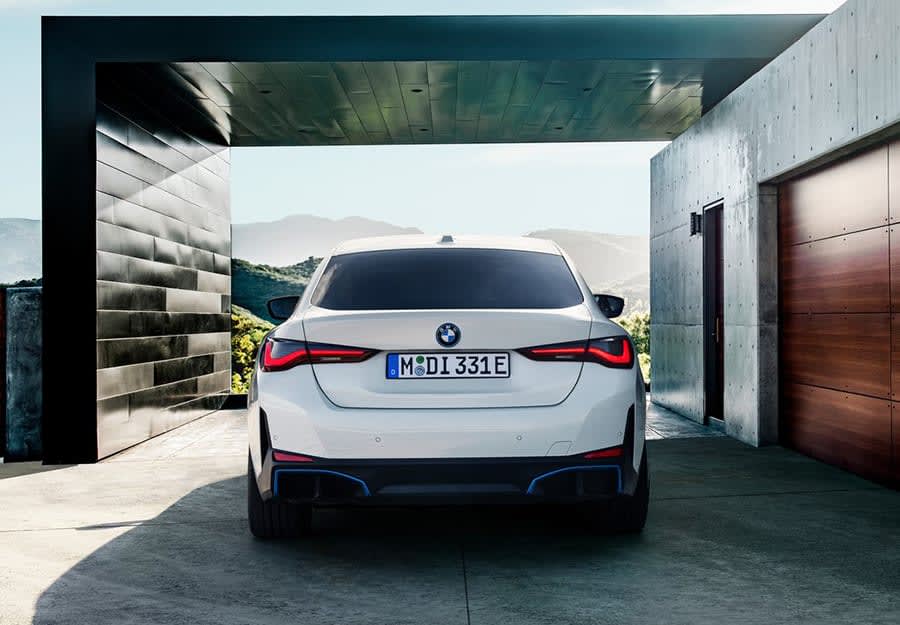
Key Features
There are two versions of the i4 to choose from. The eDrive40 features rear-wheel drive and a single electric motor.
But, unusually for BMW, it is ushering in the high-performance M-badged version at the same time. The i4 M50 has four-wheel drive, provided by two electric motors. It also includes various design tweaks on the exterior, which set it apart from the standard car, just like you will find on the M-badged cars across the BMW range.
With eDrive40, there is a choice of two trims.
Sport is entry-level and includes 17 or 18-inch alloys, LED lights, an automatic tailgate, a leather sports steering wheel, gloss-black exterior highlights, and acoustically treated glass. You also get the BMW Live Cockpit Plus (a digital instrument display) and SatNav as part of the BMW Curved Display (part of its upgraded infotainment system, which we'll cover later), as well as pre-temperature setting. This lets you warm up (or cool down) the cabin temperature before you set foot inside. A reversing camera and cruise control are included, too.
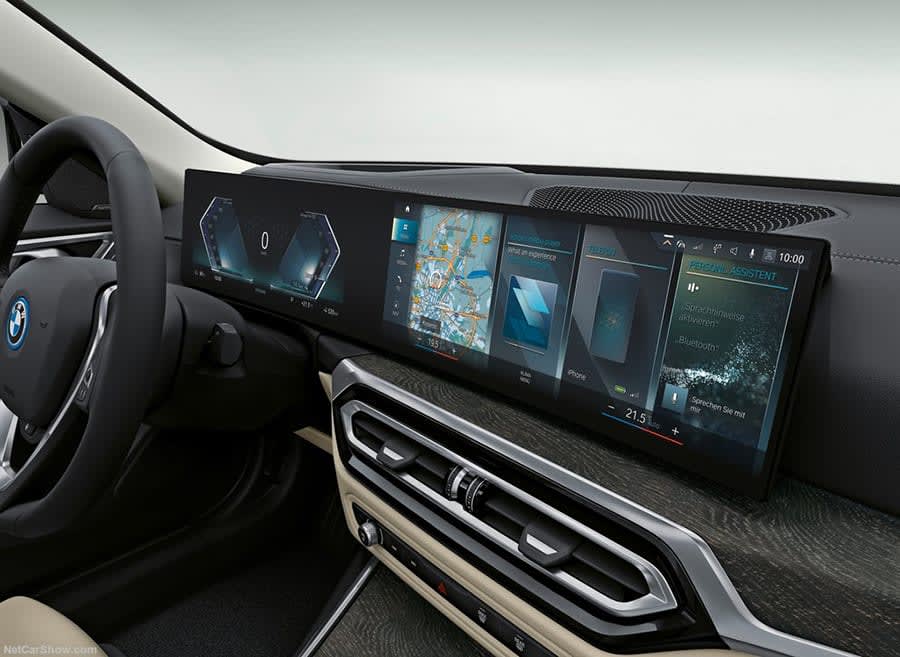
M-Sport includes all the above but has sportier wheels, a modest spoiler and grey exterior highlights.
Pick the M50, and it upgrades the alloys to 19-inches. You also get adaptive suspension, improved brakes and a flap added to the rear spoiler. A head-up display is included inside, too.
The car's exterior has also been designed with aerodynamic efficiency in mind. The alloy wheel ‘spokes’ are more like large, flat blades which improve airflow, while the door handles are flush with the door. There is also a sizeable rear diffuser to help manage the airflow as it exits from underneath.
Both the eDrive40 Sport and M-Sport have 340PS, do 0-62mph in 5.7-seconds and top out at 118mph.
The M50, meanwhile, produces 544PS, will do 0-62mph in 3.9-seconds – is as quick as an M3 Competition edition – and gets up to 140mph.
Range & Batteries
You will get a 347 to 365-mile range from the Sport. But, thanks to the additional electronic gadgetry in the M-Sport, the claimed range is slightly smaller, between 337 and 352 miles.
The M50, with all that extra grunt and an additional electric motor to power, has a range of between 258 and 318 miles.
All models include an 83.9kWh battery – and BMW has worked hard to reduce its size and weight. It is still around half a tonne, but it fits underneath the car's floor, so no boot space is sacrificed.
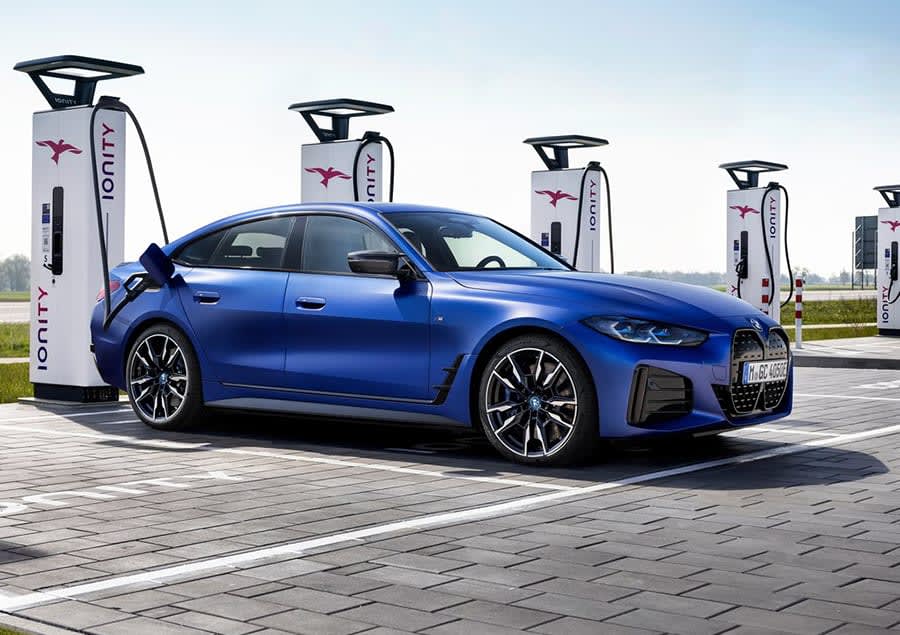
Performance & Drive
When you put your foot down, the acceleration is instantaneous, providing a brisk burst of power. It gets up to speed very quickly, especially from a standing start.
In terms of cornering, the i4 tends to understeer from the front, although the rear will eventually relent and help turn the bend. It doesn’t feel as sprightly as a petrol-powered BMW, however. A Polestar 2 feels slightly more agile and is arguably more fun to drive.
Nevertheless, it is undoubtedly very refined and relaxing to drive despite the performance-focused credentials. Wind and road noise are both minimised, in part thanks to acoustic glass windows.
The ride comfort is perfectly acceptable with the 19-inch alloys on our test car, so we have no concerns about the smaller 17 or 18-inch wheels on the standard Sport trim.
The brakes are also impressive. Many electric and hybrid cars have unpredictable stopping power thanks to regenerative braking, which converts the heat generated under deceleration to help recharge the battery.
In many vehicles, the braking can be tough to judge. But BMW seems to have mastered it in the i4. When turned up fully, you can do ‘one-pedal driving’ whereby just taking your foot off the accelerator will provide enough stopping power.
Put the vehicle into Sport mode, and you get a soundtrack composed by the famous movie music maker Hans Zimmer. The German – best known for writing the film scores for The Lion King, Gladiator and Pirates of The Caribbean – was asked to come up with an electronic accompaniment in the absence of an engine note.
This is clever, as electric cars that feature a synthetic engine noise often sound like a poor mid-1990s motor racing game. But, because this sound isn’t designed to be doing a bad impersonation of an actual engine, you accept it as a nice, futuristic compliment to 21st-century driving. Of course, some won't appreciate it, but we think it's ingenious.
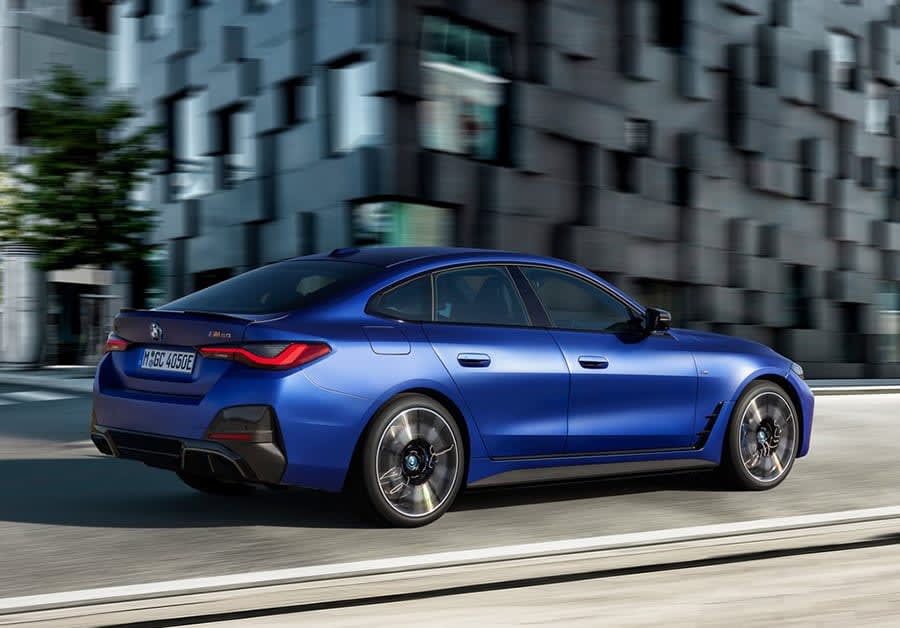
Charging
The i4’s battery can get from a 10 per cent charge to 80 per cent in around half an hour, thanks to its maximum charging rate of 210kW. Unfortunately, there aren't many charging points that can handle that much power delivery, but they are on the increase.
The Polestar 2 can’t manage over 150kW, while Tesla’s maximum is 250kW, the latter having the significant advantage of having its own supercharger network exclusive to its cars.
This could be a big factor in swaying your decision if you are going to need to charge up on the move regularly. But it will be less of an issue in time as more charging points pop up across the country.
If you only need to charge it at the office or home, this won't be a problem, though.
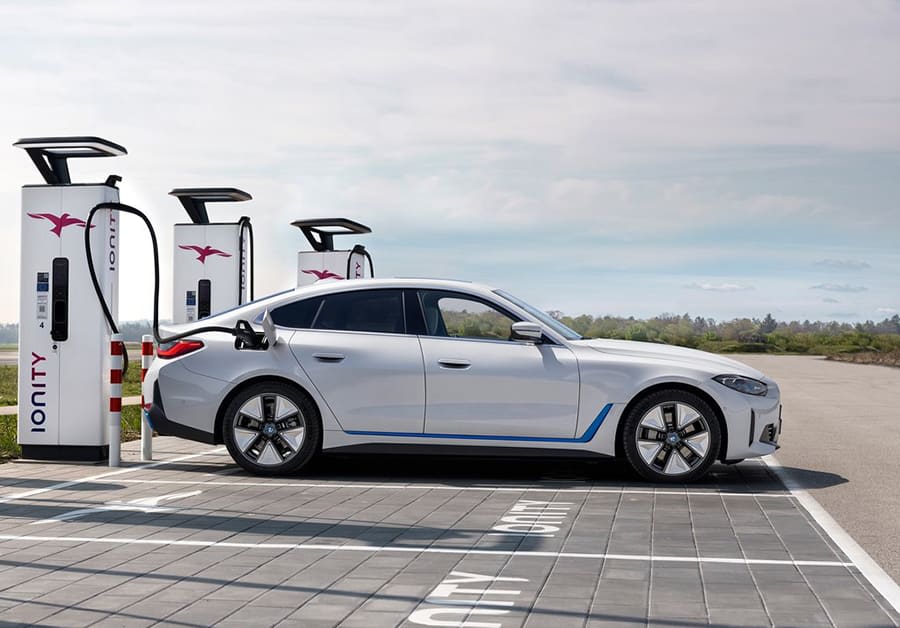
Running Costs & Emissions
Emissions are one thing you need not worry about. And, if you are conscious about the emissions used in making the car, it is worth noting that BMW has optimised the environmental impact of its manufacturing processes.
Obviously, without needing to visit petrol stations on a semi-regular basis, you will be mainly at the mercy of the cost of charging it at home or public charging points.
The prices for using the latter can vary wildly, so it is worth doing some research first on how much it is likely to cost you.
You will want to figure out how much juice you are likely to need monthly at home and find an energy tariff that meets your needs.
On the plus side, leasing costs are likely to be kept low, as the i4 is expected to hold its value well. Plus, you will benefit from having a zero-emissions car when it comes to Benefit-in-Kind (BiK) tax, making the BMW an attractive proposition for company car drivers.
Interior & Technology
Inside, the i4 looks much like any fossil-fuelled BMW’s interior. That is a good thing as, firstly, BMW makes some of the best interiors you can find. Secondly, there is no attitude of ‘we must make it look futuristic for the sake of it’.
This is a relief, as several features of the i4 concept were a bit gimmicky, including touch-sensitive gear selectors and a crystal rotary dial for the iDrive system. These, plus an odd-looking cream-coloured steering wheel, have been ditched in favour of more familiar-looking controls.
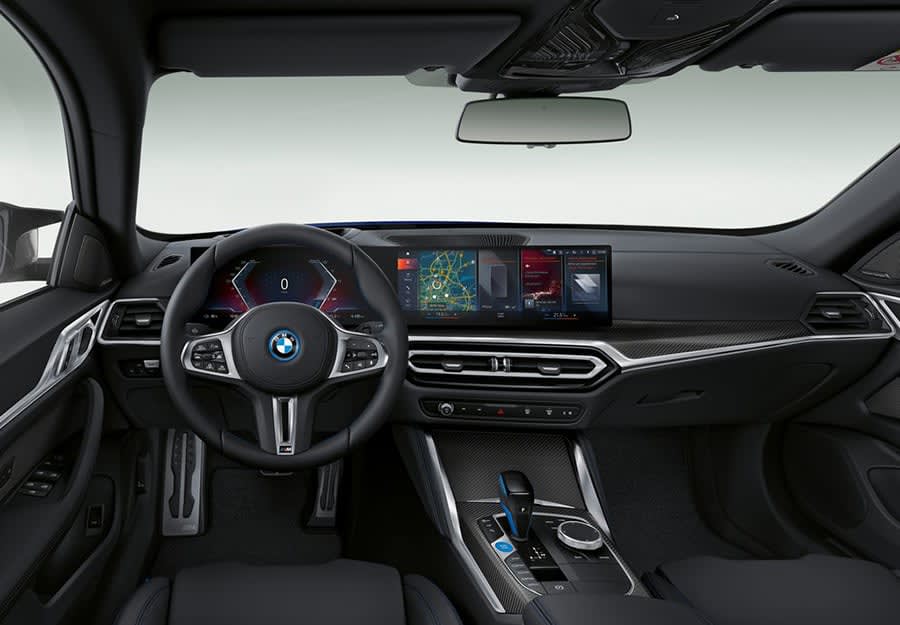
The i4 comes with iDrive 8.0, which is integrated into its Curved Display. Much like you see on new Mercedes cars, there are two screens that ‘pop’ out of the dash. The left-hand one is for the Live Cockpit Plus – a 12.3-inch digital instrument display that displays various nuggets of information, including SatNav directions. On the right is the main 14.9-inch infotainment display. It looks fantastic, is easy to use, has menus laid out in a logical order, and it is as responsive as the latest smartphone. Voice control is included and works well, too. The whole system looks and feels like the car has been designed around it, rather than the screens and system being wedged into a philistine dash.
We wish BMW hadn’t removed the physical buttons to control the air conditioning, though. These options are now within the infotainment system's menu, which can be needlessly distracting from focusing on the road. The voice control can operate it for you, which will no doubt be BMW’s counterargument.
Everything about the interior looks well-built, thought through, and well-designed. There is the odd bit of cheap plastic, but the interior is full of plush, soft-to-the-touch surfaces, giving a true feeling of superior premium quality.
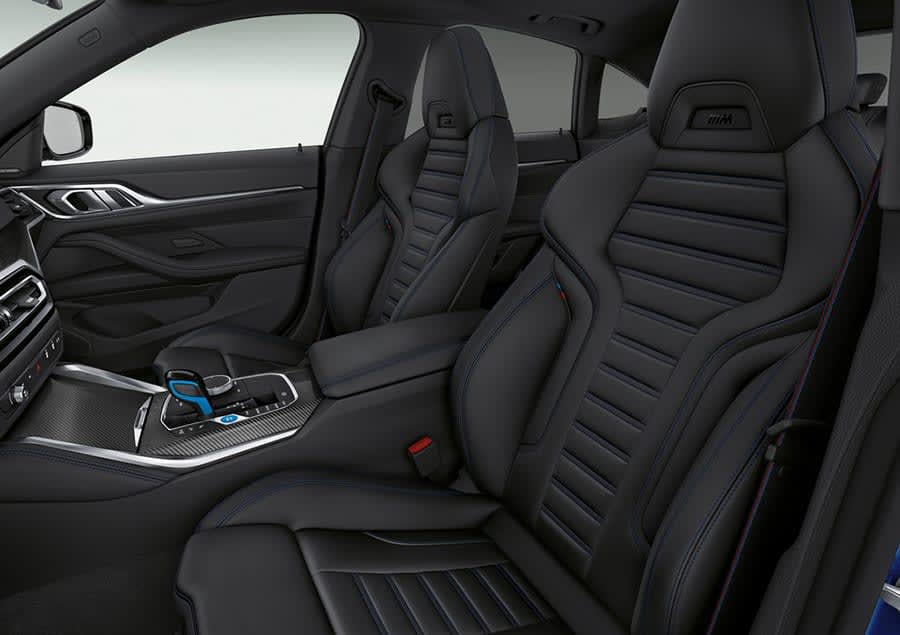
Practicality & Boot Space
The front seats are very comfortable, with plenty of space.
There is a decent amount of storage space in the cabin, too, with well-sized door bins, more space in the centre console and a decent-sized glove compartment.
In the rear, the roofline curves downwards from the car's mid-point, which does compromise headroom somewhat. However, there is still a solid amount of legroom that should accommodate all but the tallest passengers.
Three adults in the back are doable but will be a tight squeeze.
To confuse matters, although it looks like a saloon, it is marketed as a coupe, yet the boot opens like a hatchback.
The seats fold down individually in a 40/20/40 configuration, which helps if you need to get rid of one seat to fit a longer item in.
A boot capacity of 470-litres is offered, expanding to 1,290-litres with all the seats folded down. This is more than the Tesla Model 3 (425-litres expanding to 1,235-litres) and the Polestar 2 (405-litres expanding to 1,095-litres).
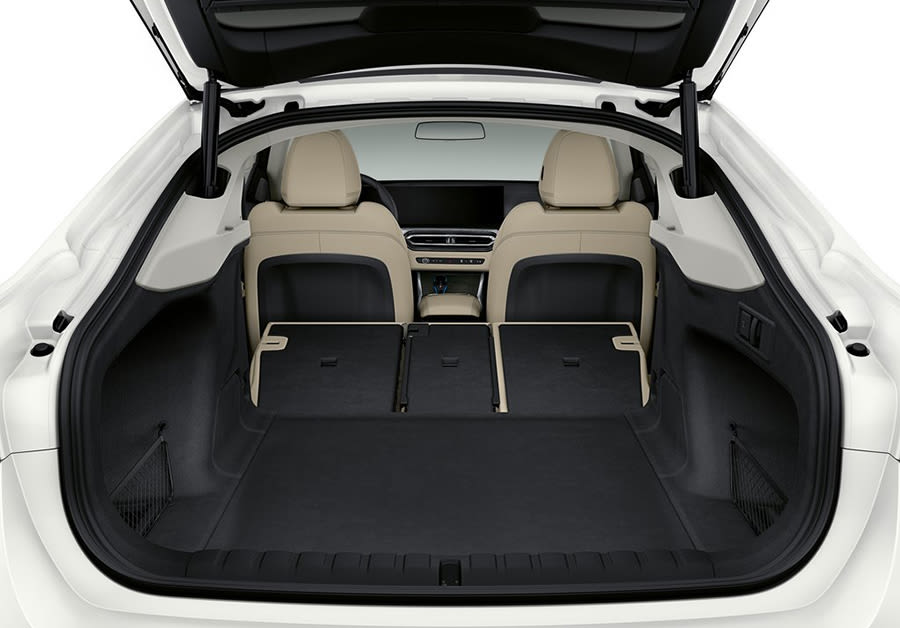
Safety
Euro NCAP hasn’t yet tested an i4. But given it is based on the 4-series Gran Coupe – which itself is based on the 3-series – it is likely to perform just as well.
The 4-series Coupe (not to be confused with the Gran Coupe) and the 3-series were tested in 2019, earning five-star ratings.
The 3-series scored 97 per cent for adults, 87 per cent for children and 76 per cent for safety assists.
In terms of safety gadgets, forward and rear cross-traffic collision warnings, automated emergency braking and lane-departure warning and lane-keep assist are offered. Adaptive cruise control is part of the stock kit as well.
You also get Driving Assistant, a camera and a radar-based assistance system. At the same time, an upgrade offers steering and lane control assist, traffic light detection and wrong-way warnings. You also get parking assistance, which is upgradeable to include a 360-degree camera.
Options
Comfort Pack, which provides a heated steering wheel and lumbar support for the front seats, is offered, while the Technology Pack with Live Cockpit Professional (which includes the heads-up display and voice control) is available, too. Furthermore, both are obtainable with ‘Plus’ upgrades.
You can also go for the Visibility Pack, which adds laser lights, and there is an electric glass sunroof option, too.
Lumbar support and a heated steering wheel are also available. Although it is worth noting that the standard equipment differs slightly between Sport, M-Sport and the M50, while some individual options are included at no extra price in the various ‘packs’ that are offered.
The default colour is solid white, although a choice of metallic paints are on hand at a cost. That said, the M50 has a selection of standard colours, with others available if, again, you raid your wallet.
Cloth upholstery is offered as standard, with a choice of leather colours offered for a four-figure sum (leather is standard on the M50).
You can choose between 17 and 18-inch alloys for no charge in the Sport trim, while 19-inch wheels are extra.
In the M-Sport trim, you can choose between 18 and 19-inch alloys for no extra charge, plus you can upgrade from the standard aluminium decor to piano black or ‘fabric’ aluminium for a few hundred pounds.
The M50 has 19-inch wheels, which are upgradeable to 20-inches.
Rival Cars
The Tesla Model 3 is the obvious alternative to the i4. And it is equally apparent that BMW has used Tesla as a benchmark when designing the car.
The M50 goes head-to-head with the Model 3 Performance version, while the standard i4 will exceed the mileage of the Model 3 Long Range version on a full charge.
The Polestar 2 is also worth checking out.
Other than that, there aren’t many direct competitors yet that are all-electric, but we don’t expect we will be waiting long.
Traditional rivals Audi, Mercedes-Benz and Jaguar all have hybrid versions of their equivalent cars.
Verdict & Next Steps
Overall, the BMW i4 is a fantastic example of the future finally being here.
It handles well, is comfortable even on larger alloys and has lightning-quick acceleration with a familiar feel on the inside.
The infotainment system is on another level to anything that has come before it and is ahead of its nearest rivals.
It isn’t necessarily the most exciting car to drive, and we would still advise a petrol-powered 3 or 4-series for those who prioritise the driving experience. Plus, the lack of charging infrastructure means that the i4’s feat of exceeding the Tesla Model 3’s range is something of a dubious accolade.
Nevertheless, the i4 is just the first example of the sort of thing we can expect from BMW – and, no doubt, its premium rivals – in the not-too-distant future.
Where to next?
View latest BMW i4 leasing deals- guide price from £543.41 per month inc VAT**
Looking for a great leasing deal? Check out our incredible range of car lease deals
New Gran Coupe? Read our latest Reviews and find the right model for you
Want to know more about leasing? Take a look at our comprehensive Leasing Guides
Interested in everything motoring? Why not catch up on all the latest Car Leasing News.
*Score based on Select’s unique meta score analysis, taking into account the UK’s top five leading independent car website reviews of the BMW i4
**Correct as of 13/01/2022. Based on 9 months initial payment, 5,000 miles over a 48 month lease. Initial payment equivalent to 9 monthly payments or £4890.69 Ts and Cs apply. Credit is subject to status.






















